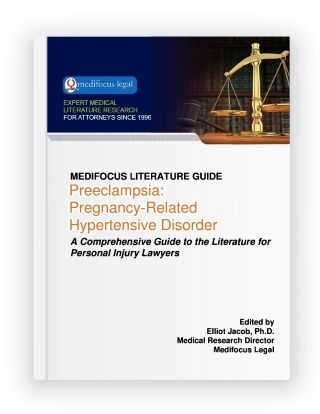Preeclampsia: Pregnancy-Related Hypertensive DisorderA Comprehensive Guide to the Literature for Personal Injury Lawyers
Publisher: Medifocus Legal
Publication Date: October 23, 2020
Number of Pages: 100
A Comprehensive Guide to the Literature for Personal Injury Lawyers
Publisher: Medifocus LegalPublication Date: October 23, 2020
Number of Pages: 100
Preeclampsia and eclampsia can also develop during the postpartum period. Postpartum preeclampsia typically develops within a few days to 6-weeks after delivery with symptoms that include high blood pressure, severe headache, visual disturbances, abdominal pain, and nausea/vomiting. Postpartum eclampsia usually occurs within 48 to 72-hours after delivery and manifests clinically with seizures. Both of these postpartum conditions can be serious and, if not diagnosed and treated quickly, can lead to serious complications including death.
Although the cause of preeclampsia is currently not known, several risk factors have been identified that include:
- First pregnancy
- Preeclampsia in a previous pregnancy
- Family history of preeclampsia
- History of chronic hypertension or kidney disease before pregnancy
- Age 40 or higher
- Obesity
- African-American ethnicity
- Pregnancy with multiple gestation
Potential maternal complications of preeclampsia include:
- Damage to vital organs such as the liver, kidney, and brain
- Thrombocytopenia - low levels of platelets in the bloodstream that can lead to bleeding problems
- Eclampsia - a potentially life-threatening condition characterized by seizures or coma
- Ischemic or hemorrhagic stroke
Potential adverse effects of preeclampsia on the fetus include:
- Placental abruption
- Preterm birth
- Miscarriage
- Intrauterine growth retardation (IUGR)
- Stillbirth
Treatment decisions for preeclampsia must take into considertion several factors including the severity of the condition, stage of pregnancy, the potential for maternal complications, and the possible risks to the fetus. Depending on the specific clinical situation, treatment options for preeclampsia include:
- Bedrest and close monitoring of the mother
- Intravenous infusion of blood pressure medications
- Delivery of the fetus
The MediFocus Literature Guide to Preeclampsia captures the clinically relevant articles published over the past 10-years in peer-reviewed medical journals and focuses on the risk factors, diagnosis, management, and prevention of this potentially serious pregnancy-related hypertensive disorder. This unique Literature Guide consists of over 130 hand-picked Review articles with links to the Abstracts and includes online access to the FREE full-text version of 41 articles. The Guide also includes a valuable Author Directory for quickly identifying and locating medical experts for case evaluation and expert testimony.
 |
- A comprehensive bibliography of 131 journal article references indexed in MEDLINE published in well respected medical and scientific journals.
- Online access to the abstracts (summaries) of the articles.
- Online access to the free full-text version of 41 articles.
- Links to full-text sources of other articles that are available for purchase directly from individual journal publishers.
- A unique "Author Directory" consisting of the names and institutional affiliations of experts who have published and have specialized knowledge about Preeclampsia: Pregnancy-Related Hypertensive Disorder. The "Author Directory" is a valuable resource for quickly identifying and locating experts for case reviews, opinions, and testimony.
Select examples of topics that are covered by the articles referenced in this Guidebook include:
- Preeclampsia beyond pregnancy: long-term consequences for mother and child.
- Pre-eclampsia through the eyes of the obstetrician and anesthesiologist.
- Pre-eclampsia: pathogenesis, novel diagnostics and therapies.
- Mode of Delivery in Severe Preeclampsia Before 28 Weeks' Gestation: A Systematic Review.
- Maternal preeclampsia and long-term offspring health
- Prediction of adverse maternal outcomes from pre-eclampsia and other hypertensive disorders of pregnancy: A systematic review.
- Aspirin for the prevention of preterm and term preeclampsia: systematic review and metaanalysis.
- Planned caesarean section versus planned vaginal birth for severe pre-eclampsia.
- Preeclampsia: Pathogenesis, Prevention, and Long-Term Complications.
- Pathophysiology and Current Clinical Management of Preeclampsia.
- Preeclampsia Screening: Evidence Report and Systematic Review for the US Preventive Services Task Force.
- Prevention of preeclampsia.
- Preeclampsia; short and long-term consequences for mother and neonate.
- First-, Second-, and Third-Trimester Screening for Preeclampsia and Intrauterine Growth Restriction.
- Cigarette smoking during pregnancy and preeclampsia risk: a systematic review and metaanalysis of prospective studies.
- Increased risk for the development of preeclampsia in obese pregnancies
- Preeclampsia: what could happen in a subsequent pregnancy?
- Major changes in diagnosis and management of preeclampsia.
- How does preeclampsia predispose to future cardiovascular disease?
- Low-dose aspirin for prevention of morbidity and mortality from preeclampsia: a systematic evidence review for the U.S. Preventive Services Task Force.
is available in two formats: | |
Order by Phone:To order by phone, please call: Order by Mail:To order by mail, please print and complete this Order Form | |

